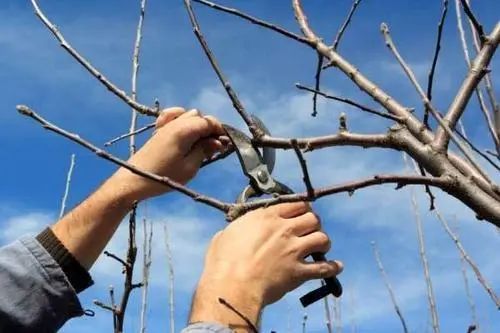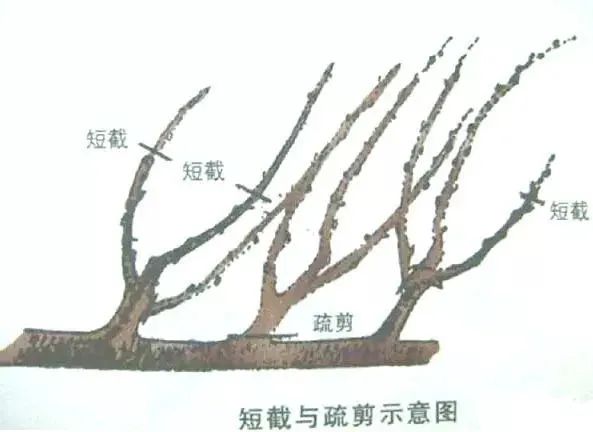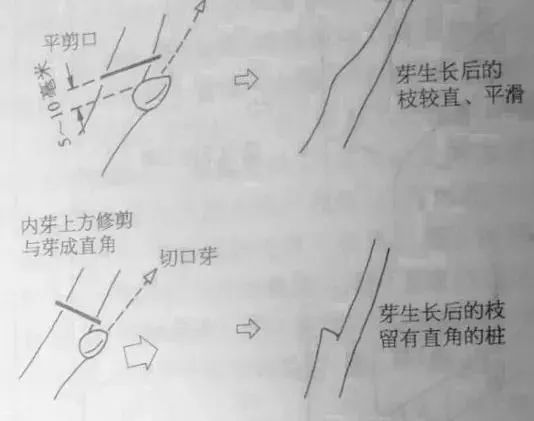 Search keywords:
Bacterial Manure Foliar Fertilizer Manufacturer Aminoacid Foliar Fertilizer
Search keywords:
Bacterial Manure Foliar Fertilizer Manufacturer Aminoacid Foliar Fertilizer
Welcome to Shandong Haidailvzhou Biology!
 Search keywords:
Bacterial Manure Foliar Fertilizer Manufacturer Aminoacid Foliar Fertilizer
Search keywords:
Bacterial Manure Foliar Fertilizer Manufacturer Aminoacid Foliar Fertilizer
Pruning in autumn and winter starts from the end of autumn when the branches stop growing and ends before the top buds germinate in early spring. Because plants are in the dormant period, their metabolism is slow, and the damage caused by pruning is also the lowest, so the large amount of pruning plastic, cutting, shrinking, etc. are carried out in autumn and winter. However, pruning in autumn and winter should also pay attention to the temperature. When the weather is severe, it is not easy to trim, so as to avoid frostbite of tree wounds. It can be carried out in the early spring before the atmosphere warms up and the root system enters vigorous activities.

Purpose of pruning in autumn and winter
Pruning is an important task in garden maintenance and management. There is often a saying of "seven divisions, three divisions cut", and autumn and winter pruning is particularly important. Reasonable pruning can achieve the effect of adjusting tree shape, promoting growth, and reducing pests.

1. Adjust the tree shape
After a year of growth, the trees have many long branches, inner branches, weak branches, cross branches, overlapping branches, diseased branches, etc. There is no shelter from branches and leaves during the dormant period. These branches can be pruned intuitively. , To cultivate a beautiful tree shape, keep the tree shape neat and beautiful.
2. Reduce nutrient consumption and increase growth
When the tree enters the dormant period, the nutrient return of the branches of the tree body, and the flow of body fluids is slow. At this time, the excess branches are reduced, and the nutrients required for budding and flowering in the next year will be reduced. It will grow vigorously in the coming year.
3. Remove old branches and diseased branches to reduce pests and diseases
Prune old, weak branches, diseased branches, cut off the overwintering germs and overwintering insect eggs on the branches, improve the ventilation and light conditions inside the canopy, and reduce the occurrence of pests and diseases.
Principles of pruning

Cup shape

Natural happy shape
2. Plastic pruning according to the biological characteristics of flowers and trees: different growth periods have different degrees of pruning, and light pruning is adopted for young trees; for adult flowering shrubs, attention should be paid to the contradiction between growth and flowering and fruit; old trees should be pruned again.
3. Plastic and pruning according to tree species: such as cedar and white magnolia with strong top dominance, to retain the main and middle trunk; osmanthus and gardenia with weak top dominance and weak branching force should not be left during plastic surgery In the dry, it forms a spherical or hemispherical shape.
4. According to the location of the flower bud, the nature of the flower bud and the pruning of the flowering period: For the flowering shrubs that bloom in spring, the flower buds are usually born on annual branches. Therefore, during the dormant season, attention must be paid to the location of flower buds, such as bauhinia and peach blossoms. In summer, the flower buds are formed on the new branches that were drawn in that year, such as crape myrtle and hibiscus.
5. According to the environmental conditions of the growth of flowering shrubs: different ecological environments have different pruning methods; different configuration environments have different pruning methods. Now the landscape arrangement of garden plants is very different from the past. The layout methods are flexible and diverse. Even if it is the same kind of plant, when we trim it, we must trim it according to its planting location, method, role in the landscape layout
Pruning method
There are three main methods for pruning trees in autumn and winter, which can be summarized as cutting, thinning, and tillering.

1. Cut
is also called short cut, which means to cut off a part of the branches. Its main purpose is to stimulate the germination of side buds, draw new shoots, increase the number of branches, and have more leaves and more flowers.
can be divided into the following types according to the degree of short cut:
light short cut: cut off the top tips of the branches (cut off 1/5 to 1/4 of the full length of the branches), stimulate the buds to germinate in the lower part of the branches, promote the production of more medium and short branches, and form more flower buds. It is often used for pruning strong branches on flowers and fruit trees. Prunus plants in ornamental flowers and trees are commonly used for pruning. Appropriate short cuts can promote new branches and increase the number of flowering.
Short cut: cut off the top of the full buds in the middle or middle and upper 1/2-1/3 of the branches, mainly used for the rejuvenation of weak branches of certain plants and the cultivation of backbone branches of various trees;
heavy pruning: cut to 2/3 to 3/4 of the full length of the branches, with great stimulating effect. After cutting, the weak buds under the cut mouth can grow into 1 to 2 vigorous vegetative branches, and short branches can be formed in the lower part. This technique is often used for the regeneration and rejuvenation of old branches or weak or old trees; extremely heavy short cut: leave 1-2 deflated buds at the base of the branches, and cut off all the rest. Lagerstroemia often uses this method.
2. Sparse
refers to the operation of pruning all the branches from the base. It is mainly used to remove the dense branches in the canopy, adjust the even distribution of the branches, promote ventilation and light transmission, reduce the occurrence of diseases and insect pests, and avoid the long-term lack of light inside the canopy, causing the branches to die and natural pruning occurs.
The target branches of thinning are: dead branches, branches with diseases and insect pests, senescent drooping branches, competitive branches, long branches, root tillers, etc. The pruning of large branches, strong branches and perennial branches will cause more damage to the tree. Generally, it should not be carried out easily, but the weak branches in the whorl branches and the small branches in the dense branches can be thinned.
3. Tiller removal
Pruning (removing) the trunk of the tree, the wounds of the large branches, and the shoots from the base of the main branches. This operation is called desprouting. It is commonly used in the plastic pruning of street trees Fatong and Lagerstroemia.
Points to note in pruning
1. The state of the cut
The cut should not be too flat (perpendicular to the main trunk) or the slope is too large: the short cut should be smooth, with a slope of 45° to facilitate rainwater drainage in the rainy season; thinning cut from the branch point, flat with the stem, leaving no residual piles .
Do not leave the upper part of the bud too long: cut down from the opposite side of the cut bud. The top of the incline is level with the tip of the cut bud, and the bottom of the incline is level with the base of the bud, so that the cut surface is small and easy to heal. After the bud germinates Grow.

(Bud growth at different cuts)
The direction of cutting buds is determined: the direction and quality of cutting buds determine the growth direction of new shoots and the growth direction of branches. The direction of cutting sprouts should be considered from the distribution of branches in the crown and the expected growth of new branches. When the crown needs to be expanded outward, the cutting sprouts should stay on the outside of the branches. In case of filling the emptiness in the inner chamber, the cutting sprout direction Should face inward, in order to inhibit the growth of branches that grow too fast, use weak buds as cut buds, and choose full and strong buds as cut buds when rejuvenating weak branches.

(Growth direction of upper and lower branches and buds)
2. The branch angle of the main branch or major backbone:
The branch angle should not be too large or too small, and should be controlled at 45°-60°, so that the tree is firm and not suitable for splitting.
3. Saw the trunk or thick branches
When pruning larger branches and trunks, the distributed operation method can be used. First, at a position 20cm above the required saw cut, cut up from the bottom of the branch to half the thickness of the trunk. Saw the branch from above, leaving a residual pile, and then saw the residual pile at the cut. Avoid splitting the trunk.
For large pruning wounds, apply plant wound healing ointment for wound disinfection and healing treatment to prevent pests from invading the wound and protect the tree from evaporation and loss.

Antibacterial, water retention, wound healing
4. The order of shaping and trimming:
It should be "from the stem to the corner of the tree"; from the inner chamber to the periphery; pruning upward from the stem of the main branch; trim the large branches first, then the middle branches, and finally the small branches; finally, perform a review to avoid errors or omissions.
Pruning period of different tree species
The pruning period of deciduous trees and evergreen trees is different:
Pay attention to two points when pruning evergreen trees:
1. The pruning of evergreen broad-leaved trees should be carried out during the active growth period of April to October when the branches and leaves are complete. Avoid winter. It is better to cut short from June to July to avoid loss of nutrients and freeze damage.
2. Evergreen conifers should be carried out in the early winter before the new shoots stop growing until the early spring buds sprouting. At this time, the wound will heal quickly and the nutrient loss will be less. A small amount of thinning can be used during operation. Keep in mind that conifers should not be short cut. The short stubble should not be cut close to the base of the branches. This is completely different from the thinning requirements of deciduous trees.

Tips for pruning deciduous trees in winter:
①Strong branches lightly cut, weak branches heavy cut;
② "Short cut" should be divided into four levels: light, medium, heavy, and extremely heavy, and deal with it flexibly according to tree potential and needs;
③ "Sparse branches" should mainly consist of dead branches, diseased branches, drooping branches, long branches, overlapping branches, cross-competitive branches, and root tiller branches. Be careful not to remove too many branches and ensure the total leaf area of ??the whole tree. When pruning, it should be close to the base of the branches, and no stubble should be left;
④ "Retracting pruning" is to reduce the dominance of the canopy top and improve the light;
⑤ "Topping" is to promote lignification of branches and prevent new shoots from growing;
⑥ "Remove Meng" is to save the nutrient consumption of the tree and clean the tree shape;
⑦ "Head changing" is to prevent the canopy from being hollow and change the appearance of the canopy;
⑧ "Large branch re-cutting" is to restore growth, promote roots to keep alive, and balance absorption and evaporation.
The deciduous trees stop growing in winter. At this time, pruning loses the least nutrients and the wounds heal quickly. Although evergreen trees are dormant in winter, cutting off the branches and leaves is dangerous. Because the roots and branches of evergreen trees are active throughout the year and their metabolism is not stopped, the nutrients in the leaves are not completely used for storage. When the branches and leaves are cut off, Among them, the loss of nutrients affects the growth of trees. The pruning period of evergreen trees is generally in late spring after winter.
Pruning tools should be kept sharp. Before going up the tree, check whether the various parts of the ladder are flexible and whether they are loose to prevent accidents. Pay special attention to safety when working near high-voltage lines to avoid electric shock. If necessary, work after power off. When pruning sidewalk trees and playgrounds, special personnel are assigned to maintain the site to prevent large branches from being sawed and hurting passing pedestrians and vehicles.


TOP